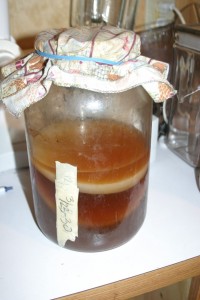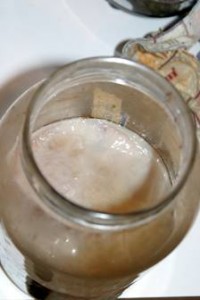All of us love this stuff.
It’s full of B-complex vitamin, is slightly fizzy, and has a refreshing bite to it when it is done well. It usually goes pretty fast, so I make about 2 gallons at a time. There are several recipes out there, but the basic one uses black tea and white sugar. Here is what I do:
1 gallon of water
6 teabags of black tea (organic)
1 cup sugar (organic)
12 minutes
Bring the water to a boil and remove from heat. Add the teabags, and cover the pot. Steep for 12 minutes, and then remove the tea. Add the sugar and stir—it will dissolve quickly. Let it cool to below 100°F/38°C and add it to your fermenting container.
The kombucha “mushroom” or SCOBY (Symbiotic Culture Of Bacteria and Yeast) needs fresh air, so your container should have as much width at the depth of the liquid. Since I use 1 gallon glass jars, it means that I only fill them half full. The SCOBY can get pretty thick, and there’s also a cup or two of ripe kombucha in with it when I start. That means it takes me 5 jars to ferment my 2 gallons of sweet tea. I use cloth around the tops of the jars, held in place by rubber bands.
Depending on how strong you like it, it takes 7-10 days until the kombucha is ready to drink, so I use a strip of masking tape on the jars to show when the batch was made, and when it should be ready to serve.
When time allows, I like to bottle it up after day 4. It takes another week or more to finish that way because the bottle seals off the oxygen. The result though is a refreshing carbonated drink that can travel easily without spilling. Grolsch beer bottles work great for this–I picked several cases of used bottles after a couple weeks of watching www.craigslist.com.
A note about fluoride and tea:
The tea plant naturally concentrates fluoride from its environment.
“Tea is very high in fluoride because tea leaves accumulate more fluoride (from pollution of soil and air) than any other edible plant.” http://www.westonaprice.org/Fluoride-Worse-than-We-Thought.html
I strongly recommend using an organic source of black tea because fluoride is a component of many agricultural pesticides. It gets sprayed on the plant, and then the tea plant extracts any overspray out of the soil and concentrates it into the leaves that you use.
Many parts of the country have fluoridated city water, so you might get to deal with the “double whammy” of steeping fluoride out of the teabag into the fluoridated tap water. Our current solution is a quality de-ionizing water filter and organic black tea.


